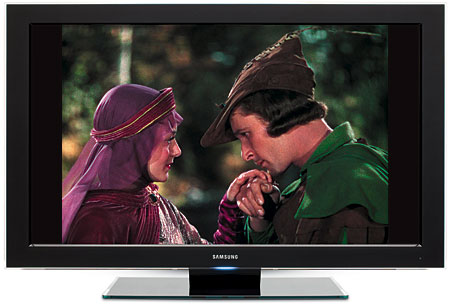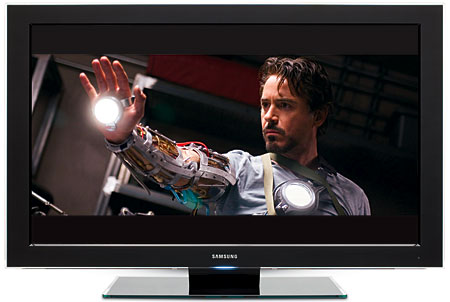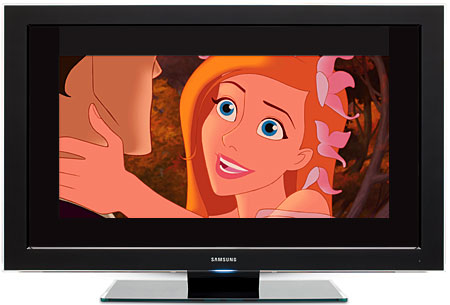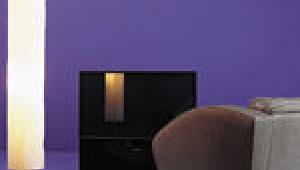Aspect Ratio Oddities
By now, most home theater fans have undoubtedly grown used to seeing letterbox bars on many movies they watch. In today’s high-definition era, any content with an aspect ratio that’s greater than a 16:9 (a.k.a. 1.78:1) HDTV screen must be presented with black bars on the top and bottom of the frame. Blu-ray viewers have many examples of this. Approximately half of all modern theatrical films are photographed in the scope aspect ratio of 2.40:1. Iron Man, Tropic Thunder, and Wall-E fall into that category. Scope photography is sometimes referred to as 2.35:1 for reasons that are too complicated to explain in detail here. Just know that 2.40:1 is technically correct, although many people in the industry continue to use the term 2.35:1 interchangeably. At the other extreme, material narrower than 16:9 (classics like Casablanca and The Adventures of Robin Hood are 1.37:1) will have pillarbox bars on the sides. In the middle, movies composed for 1.85:1 (such as the The Sixth Sense, Hellboy, or Knocked Up) nearly fill an HDTV.

1.37:1 with pillarbox bars
Those are the most common aspect ratios, but by no means are they the only ones. Filmmakers are creative people who sometimes like to experiment with their screen shapes. The results of this have started to appear on Blu-ray and require a new way of thinking about aspect ratios and letterboxing. For example, Disney’s Enchanted begins its animated prologue at a narrow 1.85:1 and then expands horizontally to 2.40:1 when the heroine hits live-action New York City. Movie theaters projected the film onto a scope screen with some pillarboxing at the beginning that went away at the changeover. On a 16:9 HDTV, that opening section has what is known as windowboxing, where black bars surround the picture on all four sides. That must seem very strange to viewers who aren’t prepared for it in advance. The alternative would be to have the 1.85:1 footage fill the screen and then shift to letterboxing at the 2.40:1 transition. Unfortunately, displaying the animated footage larger than the live-action footage would have the opposite of the intended psychological effect. The way the movie appears on Blu-ray is a compromise, but it’s a compromise that best maintains the director’s intent for those scenes.

1.85:1 nearly fills an HDTV
For The Dark Knight, Christopher Nolan famously shot some scenes using IMAX cameras that have a larger film area and higher-quality image than traditional 35mm. The majority of the movie was photographed in 35mm with Panavision anamorphic lenses for an aspect ratio of 2.40:1. However, the IMAX footage has a native aspect ratio of 1.44:1. The standard 35mm release prints that shipped to most theaters were matted to a consistent 2.40:1 ratio throughout. But that wasn’t the case for the prints that played in IMAX theaters. They regularly switched between 2.40:1 (letterboxed in the middle of the huge IMAX screen) and the full 1.44:1 that expanded vertically in both directions.

2.40:1 with letterbox bars
This presents a particular problem for home video. If the filmmakers presented each section of the movie in its precise original aspect ratio, the 1.44:1 IMAX scenes would wind up pillarboxed in the center of a 16:9 HDTV. That would make them narrower and smaller than the 2.40:1 letterboxed scenes. It would destroy the effect of expanded scale that the IMAX footage was meant to evoke. To work around this, Warner Home Video opted for two separate approaches. The standard-def DVD release replicates the 35mm theatrical screenings with an unchanging 2.40:1 aspect ratio. Meanwhile, the Blu-ray release switches from letterboxed 2.40:1 to full-screen 1.78:1 during the IMAX scenes. This is another compromise and one that actually makes a physical change to the photography’s aspect ratio. Like Enchanted, it’s the best compromise to achieve the proper sense of changing scale that the director desired. Fortunately, Nolan composed The Dark Knight’s IMAX scenes knowing that aspect ratio flexibility was needed. The footage isn’t negatively affected by the cropping from 1.44:1 to 1.78:1.

Enchanted 1.85:1 with window box
Perhaps the strangest aspect ratio ever seen on home video comes with the Blu-ray release of the classic 1962 Western How the West Was Won. The movie was photographed in the short-lived Cinerama format by a huge camera with three lenses. When displayed in a genuine Cinerama theater, three projectors shone the movie onto an enormous curved screen that filled the viewers’ entire field of vision. The effect is nearly impossible to reproduce on home video. Previous DVD and Laserdisc transfers crudely merged the three Cinerama segments into a single letterboxed image with join lines at the intersection of each panel. Due to registration and coloring errors, the sides of the picture often looked disconnected from the center. For the new Blu-ray release, Warner Home Video meticulously restored the movie by scanning each panel separately and digitally integrating them all back into one complete image. Warner has largely (though not entirely) removed the join lines, and the picture is vastly more consistent and satisfying in appearance.

Enchanted 2.40:1
- Log in or register to post comments



























































